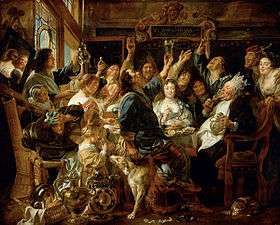Bean-feast
A bean-feast was an informal term for a celebratory meal or party, especially an annual summer dinner given by an employer to his or her employees, probably derived from a tradition in the Low Countries at Twelfth Night.[1] By extension, colloquially, it describes any festive occasion with a meal and perhaps an outing.[2] The word, and its shorter form "beano", are fairly common in Britain, less known in the United States. An alternative derivation refers the name to the eating of a dish of beans and bacon, and seems to trace to 1725, when Daniel Day of Wapping, London began to entertain friends near his estate at Fairlop in Essex on the first Friday in July.[3]

A goose, which is the raison d’être of the feast, has been dropped out of the name, though a goose was always the staple of the entertainment. A “bean-goose” is a migratory bird, arriving in UK in autumn and going northwards in April. It takes its name from the likeness of the upper part of the bill to a horse-bean.
In the nineteenth and early twentieth centuries, the beanfeast often took the form of a trip to some beauty spot, where the meal was provided. (e.g. ..I want a feast, I want a bean feast. Cream buns and doughnuts and fruitcake with no nuts, so good you could go nuts. — Veruca Salt, Willy Wonka & the Chocolate Factory)
It is derived from the Twelfth Night feast, at which a king cake or pie with a special object or "favour" buried in it was a great feature. This remains a common custom in much of Europe and former European colonies; in the US mainly in New Orleans.[4] Elsewhere the favour took various forms, including metal tokens and small pottery figures. In the Low Countries a bean was usual. The bean king for the rest of the night was the person who had the slice of cake containing the bean.[1] The king (or queen) was given a paper crown to wear, and appointed various court officials. When the king took a drink, all the party shouted "the king drinks". The subject was often painted by Flemish Baroque and Dutch Golden Age painters, especially Jacob Jordaens and Jan Steen.[5]
See also
References
| Wikimedia Commons has media related to Bean-feast. |
- Chisholm, Hugh, ed. (1911). . Encyclopædia Britannica. 3 (11th ed.). Cambridge University Press. p. 573.
- From Merriam Webster Unabridged Dictionary
- Beauties of England and Wales, Volume 10, Issue 3, Part 1, By Britton, pub. T. Maiden, 1815
- Mardi Gras, Gumbo, and Zydeco: Readings in Louisiana Culture, eds Marcia G. Gaudet, James C. McDonald, p. 48
- Hermitage Museum; ; Beans: A History, Ken Albala, p. 45